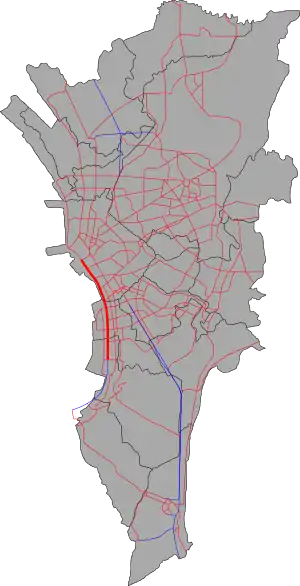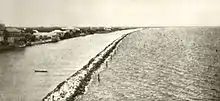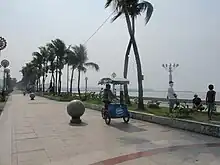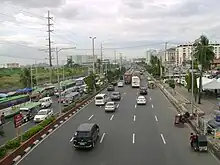Roxas Boulevard
Roxas Boulevard is a popular waterfront promenade in Metro Manila in the Philippines. The boulevard, which runs along the shores of Manila Bay, is well known for its sunsets and stretch of coconut trees. The divided roadway has become a trademark of Philippine tourism, famed for its yacht club, hotels, restaurants, commercial buildings and parks.
_sign.svg.png.webp) .svg.png.webp)
R-1 | |
|---|---|
 The route of Roxas Boulevard within Metro Manila. Roxas Boulevard is highlighted in red. | |
 Top view of Roxas Boulevard in Manila | |
| Route information | |
| Maintained by the Department of Public Works and Highways[1][2] | |
| Length | 7.6 km (4.7 mi) |
| Existed | 1910s–present |
| Component highways |
|
| Major junctions | |
| North end | |
| South end | |
| Location | |
| Country | Philippines |
| Major cities | Manila, Pasay, and Parañaque |
| Highway system | |
| |
The boulevard was completed in the 1910s. Originally called Cavite Boulevard,[5][6] it was renamed Dewey Boulevard in honor of the American admiral George Dewey, whose forces defeated the Spanish navy in the Battle of Manila Bay in 1898, Heiwa Boulevard in late 1941 during the Japanese occupation,[7] and finally Roxas Boulevard in the 1960s in honor of President Manuel Roxas, the fifth president of the Philippines. It was also designated as a new alignment of the Manila South Road that connects Manila to the southern provinces of Luzon.[8]
The boulevard is also an eight-lane major arterial road in Metro Manila designated as Radial Road 1 (R-1) of Manila's arterial road network, National Route 61 (N61), the shortest primary route in the Philippines, National Route 120 (N120) of the Philippine highway network and a spur of Asian Highway 26 (AH26). The arcing road runs in a north–south direction from Luneta in Manila and ends in Parañaque at the intersection of MIA Road and Seaside Drive, beneath the elevated NAIA Expressway.[9] Beyond its southern terminus, starts the Manila–Cavite Expressway (E3), also known as the Coastal Road, or more recently, CAVITEX.
History

City Beautiful movement
The Cavite Boulevard was part of Architect Daniel Burnham's plan for beautifying the city of Manila.[10] At the request of Commissioner William Cameron Forbes, Burnham visited the country in 1905 at the height of the City Beautiful movement, a trend in the early 1900s in America for making cities beautiful along scientific lines, for the future urban development of Manila and Baguio.[11]
Original concept


According to Burnham's original concept of the Cavite Boulevard, the bayfront from the Luneta southward should be a continuous parkway, extending in the course of time all the way to the Cavite Navy Yard about 20 miles (32 km) away. This boulevard, about 250 ft (76 m) in width, with roadways, tramways, bridle path, rich plantations, and broad sidewalks, should be available for all classes of people in all sorts of conveyances, and so well shaded with coconut palms, bamboo, and mangoes as to furnish protection from the elements at all times.
"In order to make the boulevard presentable and useful as soon as possible, a quick-growing tree like the acacia might be planted, alternating with the trees of slower growth, and be replaced after the latter attain their growth. The boulevard's seaward side should be planted so as to interrupt occasionally the view of the sea and, by thus adding somewhat of mystery, enhance the value of the stretch of ocean and sky. The boulevard would be on reclaimed land to about as far south as the old Fort San Antonio Abad in Malate, beyond which it strikes the beach and follows the shoreline to Cavite. The possible extension of the ocean boulevard along the north shore would naturally depend upon the development of the town in that direction and upon the question of additional harbor works north of the Pasig River."[11]
During the 1945 Battle of Manila, however, the Japanese forces cut down palm trees along the boulevard to convert it to an improvised runway.
Route description
Roxas Boulevard starts at Rizal Park in Manila as a physical continuation of Bonifacio Drive. The road passes through many tall buildings, restaurants, banks, monuments, and other establishments as it curves along Manila Bay. The United States Embassy is located in the vicinity of Rizal Park; a kilometer south, the headquarters of Bangko Sentral ng Pilipinas (BSP) and Philippine Navy are located within the Malate district of Manila. After the BSP building, the boulevard enters Pasay, passing through the Cultural Center of the Philippines (CCP Complex) and Star City. It then intersects with Gil Puyat Avenue and Jose W. Diokno Boulevard, where it ascends through the Gil Puyat Flyover. It then parallels Macapagal Boulevard. It ascends again to intersect Epifanio delos Santos Avenue (EDSA) through the flyover of the same name; there, the route number transitions from N120/AH26, a secondary road, to N61, a primary road. A few meters after passing EDSA, it enters Parañaque, continues into a straight route until it ends on an intersection with MIA Road and Seaside Drive, where the road continues south as Manila–Cavite Expressway (CAVITEX/E3), which is also known as Coastal Road.
Landmarks

.jpg.webp)

Churches
Urban parks
Entertainment parks
Plazas
- Plaza Nuestra Señora de Guia
- Plaza Rajah Sulayman
CCP Complex
Government buildings
Foreign embassies
- Embassy of the United States in Manila
- Embassy of Japan in Manila
Museums
- Metropolitan Museum of Manila
- Museo Pambata
- Bangko Sentral ng Pilipinas Money Museum
- Asian Institute of Maritime Studies Museo Maritimo
Hotels
- Manila Hotel
- Diamond Hotel Manila
- Sofitel Philippine Plaza Manila
- Heritage Hotel Manila
- Midas Hotel and Casino
- Admiral Hotel
- Bayview Park Hotel Manila
- City of Dreams Manila
Yacht club
Educational Institutions
Intersections


Intersections are numbered by kilometer post, with Rizal Park in Manila designated as kilometer 0. The kilometer count is discontinuous.
| Province | City/Municipality | km[1][2] | mi | Destinations | Notes |
|---|---|---|---|---|---|
| Parañaque | 7.444 | 4.625 | Southern terminus; continues south as | ||
| 6.546 | 4.067 | Asean Avenue (Aseana Avenue) | Southbound access only; northbound access via U-turn slot under EDSA Flyover | ||
| 6.348 | 3.944 | No left turn allowed from southbound | |||
| 6.099 | 3.790 | Bradco Avenue | Southbound access only; northbound access via U-turn slot under EDSA Flyover | ||
| 5.811 | 3.611 | Redemptorist Road | Northbound access only | ||
| Pasay | South end of EDSA Flyover | ||||
| 5.256 | 3.266 | End of AH26 overlap; route number change from N61 to N120 | |||
| North end of EDSA Flyover | |||||
| 4.191 | 2.604 | Arnaiz Avenue | Northbound access only; southbound access via U-turn slot under Buendia/Gil Puyat Flyover | ||
| South end of Gil Puyat Flyover | |||||
| 4.469 | 2.777 | ||||
| North end of Gil Puyat Flyover | |||||
| Manila | 2.581 | 1.604 | Pablo Ocampo Street / Pedro Bukaneg Street | No left turn allowed from northbound and southbound | |
| 2.121 | 1.318 | ||||
| 2.349 | 1.460 | San Andres Street | Northbound access only | ||
| Remedios Street | Northbound access only | ||||
| 1.062 | 0.660 | Pedro Gil Street | |||
| Padre Faura Street | Northbound access only | ||||
| 0.000 | 0.000 | Kilometer zero (Kilometer count reverses) | |||
| 0.205 | 0.127 | Northern terminus; continues north as | |||
1.000 mi = 1.609 km; 1.000 km = 0.621 mi
| |||||
See also
References
- "South Manila". DPWH Road Atlas. Department of Public Works and Highways. Archived from the original on December 22, 2015. Retrieved December 12, 2015.
- "Metro Manila 2nd". DPWH Road Atlas. Department of Public Works and Highways.
- "Manila map". University of Texas at Austin Library. Retrieved on June 5, 2011.
- "Rizal Park-Manila Map". Google Maps. Retrieved on June 5, 2011.
- "United States Congressional serial set, Issue 5280 - Act no. 1745, Section 2a", pg. 417. Government Printing Office, Washington.
- Map of city of Manila and vicinity (Map). 1:10560. Manila?: Office of Dept. Engineer, Phil. Dept. 1919. Retrieved October 10, 2021.
- Executive Order No. 41, s. 1942 (1942). Changing the name of Dewey Boulevard to Heiwa Boulevard; Taft Avenue to Daitoa Avenue; Harrison Boulevard to Koa Boulevard; Jones Bridge to Banzai Bridge; Harrison Park to Rizal Park; and Wallace Field and Burnham Green to Plaza Bagong Filipinas. Retrieved April 26, 2021.
- Executive Order No. 483 (November 6, 1951). Establishing the Classification of Roads. Retrieved September 23, 2021.
- "Intersection of Roxas Blvd. and NAIA Rd". Google Maps. Retrieved on June 5, 2011.
- (1910). "Report of the Philippine Commission to the Secretary of War", pg.68. Government Printing Office, Washington.
- (1907-03). "Far Eastern Review - Details and Description of the Burnham Plans for the Reconstruction of Manila", pg.322. Google Books. Retrieved on April 13, 2012.